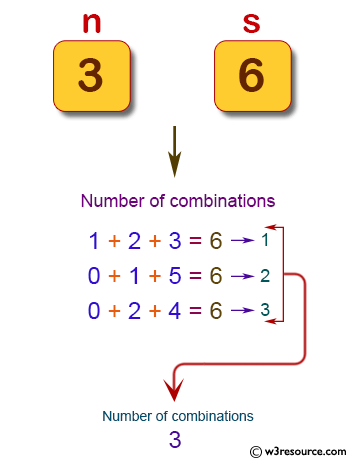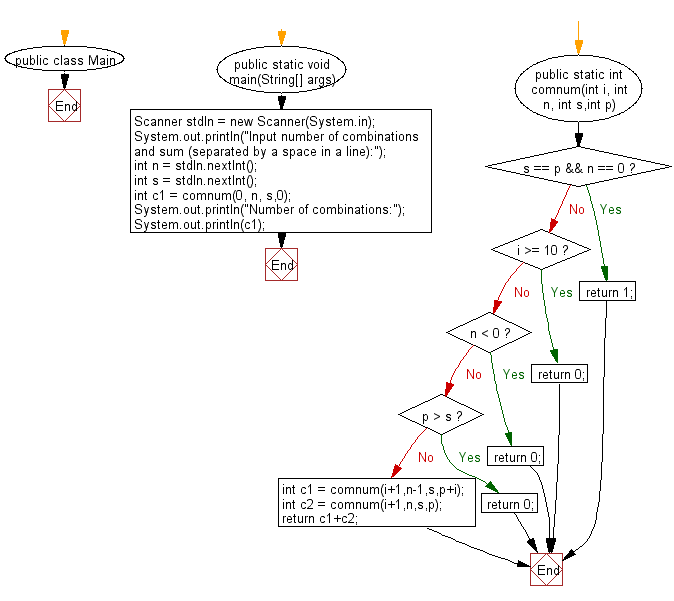Java: Reads n digits (given) chosen from 0 to 9 and prints the number of combinations
Count Combinations of Digits with Target Sum
Write a Java program that reads n digits (given) chosen from 0 to 9 and prints the number of combinations where the sum of the digits equals another given number (s). Do not use the same digits in a combination.
For example, the combinations where n = 3 and s = 6 are as follows:
1 + 2 + 3 = 6
0 + 1 + 5 = 6
0 + 2 + 4 = 6
Input:
Two integers as number of combinations and their sum by a single space in a line. Input 0 0 to exit.
Visual Presentation:

Sample Solution:
Java Code:
// Importing the Scanner class for user input
import java.util.*;
// Main class named "Main"
public class Main {
// Main method to execute the program
public static void main(String[] args) {
// Creating a Scanner object for user input
Scanner stdIn = new Scanner(System.in);
// Prompting the user to input the number of combinations and sum (separated by a space in a line)
System.out.println("Input number of combinations and sum (separated by a space in a line):");
// Reading the number of combinations (n) and the sum (s) from the user
int n = stdIn.nextInt();
int s = stdIn.nextInt();
// Calling the comnum method to calculate the number of combinations
int c1 = comnum(0, n, s, 0);
// Prompting the user with the number of combinations
System.out.println("Number of combinations:");
System.out.println(c1);
}
// Recursive method to calculate the number of combinations
public static int comnum(int i, int n, int s, int p) {
// Base case: If the sum (p) matches the target sum (s) and no more elements (n) are left
if (s == p && n == 0) {
return 1;
}
// Base case: If all elements are considered (i reaches 10), return 0
if (i >= 10) {
return 0;
}
// Base case: If the sum (p) exceeds the target sum (s), return 0
if (p > s) {
return 0;
}
// Recursive calls for including and excluding the current element
int c1 = comnum(i + 1, n - 1, s, p + i);
int c2 = comnum(i + 1, n, s, p);
// Returning the sum of combinations from both recursive calls
return c1 + c2;
}
}
Sample Output:
Input number of combinations and sum (separated by a space in a line): 3 6 Number of combinations: 3
Flowchart:

For more Practice: Solve these Related Problems:
- Write a Java program to count unique combinations of n digits (0–9) that sum to a target without repeating any digit.
- Write a Java program to count combinations of digits that sum to a target using recursion with memoization.
- Write a Java program to determine the number of digit combinations summing to a target and output one valid combination.
- Write a Java program to compute the number of combinations of digits that sum to a target, ensuring the digits appear in increasing order.
Go to:
PREV : Most Frequent and Longest Words in Text.
NEXT : Check Rectangle or Rhombus from Parallelogram Sides.
Java Code Editor:
Contribute your code and comments through Disqus.
What is the difficulty level of this exercise?
Test your Programming skills with w3resource's quiz.
